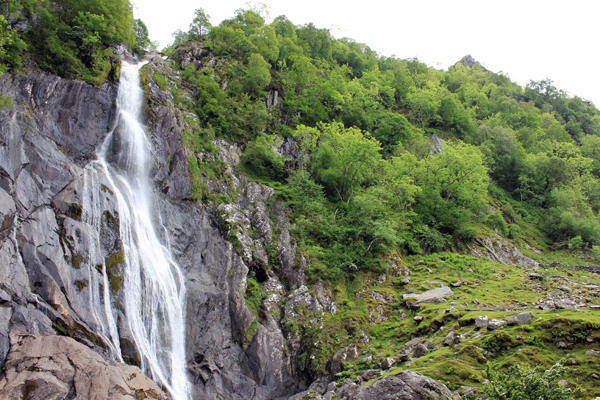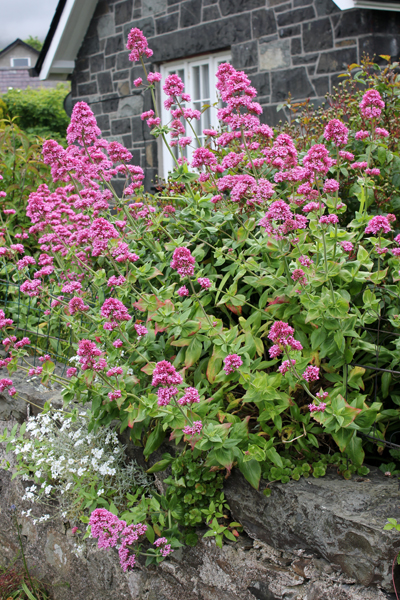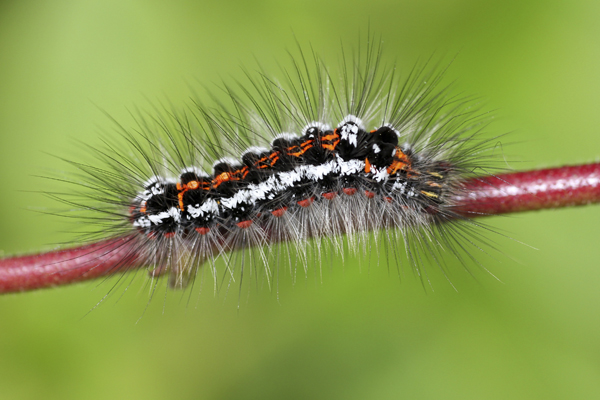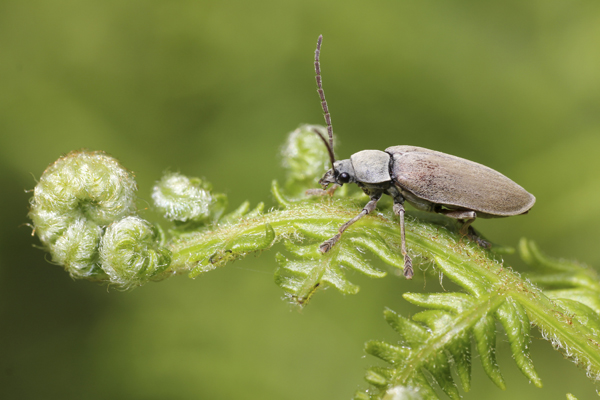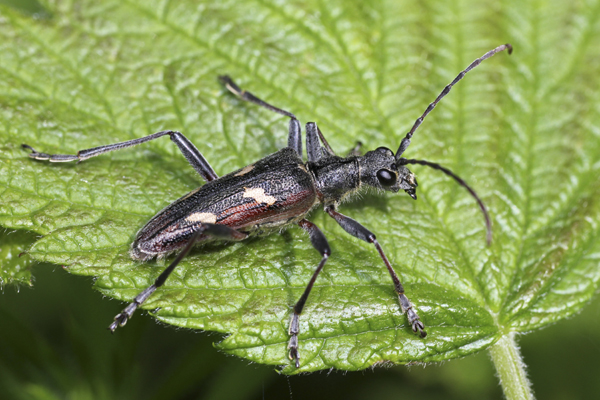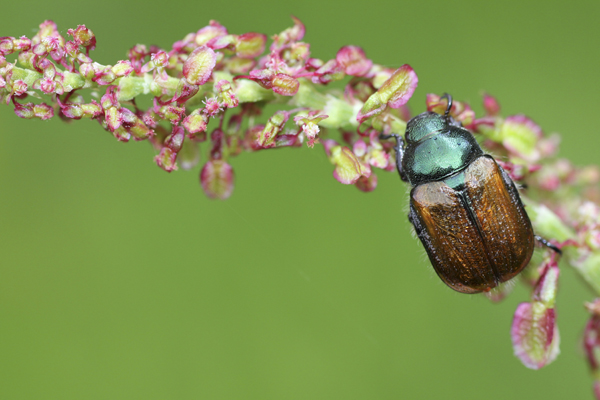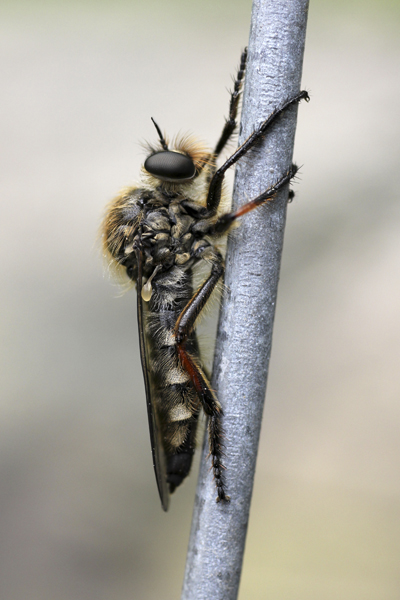After dropping off the half a dozen members to explore the National Trust’s Bodnant Gardens the remainder continued the short distance to the village of Abergwyngregyn and a walk to Aber Falls . The Aber Valley is geologically rich with exposures of Ordovician and Cambrian rocks. The waterfall (Rhaeadr Fawr in Welsh) is formed as the Afon Goch plunges about 120 feet over a sill of igneous rock called Granophyre in the foothills of the Carneddau range.
Red Valerian
We walked up through the picturesque village with stone and slate built cottages and gardens containing some unusual architectural plants such as Gunnera sp. as well as native species adorning the verges – Welsh Poppy Meconopsis cambrica, Yellow Corydalis Pseudofumaria lutea, Maidenhair Spleenwort Asplenium trichomanes, Wall-rue Asplenium ruta-muraria, Navelwort Umbilicus rupestris, Biting Stonecrop Sedum acre, Tutsan Hypericum androsaemum, Common Figwort Scrophularia nodosa, Ivy-leaved Toadflax Cymbalaria muralis, Wood Avens Geum urbanum, Foxglove Digitalis purpurea, Red Valerian Centranthus ruber, Hedge Woundwort Stachys sylvatica and Ramsons Allium ursinum.
Yellow-tail Moth caterpillar
We spotted a hairy caterpillar of the Yellow-tail Moth Euproctis similis the adults sport silky white wings and a white body with a yellow anal tuft. I also saw a Red-headed Cardinal Beetle Pyrochroa serraticornis.
We stopped at Bont Newydd bridge, a magnificent stone bridge that crosses the Afon Rhaedr Fawr and watched as a pair of Grey Wagtails were feeding in the pebbles adjoining the River then flew up and entered a crack in the stones on the bridge where judging by their beakfuls of food they must have a growing brood of chicks. Les Hale spotted a Hummingbird Hawkmoth Macroglossum stellatarum visiting Honeysuckle Lonicera sp. in a garden beside the bridge. Map Lichen Rhizocarpon geographicum that favours mountainous areas of low air pollution was covering the bridge stone work and Shining Crane’s-bill Geranium lucidum and Herb-Robert Geranium robertianum were growing from any cracks.
A Wood Warbler gave a brief trill of song from close to the car park and Yellow Pimpernel Lysimachia nemorum and Ground-ivy Glechoma hederacea were noted. From here the track continued up the valley through Coedydd Aber National Nature Reserve consisting of oak and coniferous woodland and open grassland. Plenty of bird activity with Woodpigeon, Cuckoo, Common Redstart, Blackbird, Mistle Thrush, Garden Warbler, Blackcap, Common Chiffchaff, Willow Warbler, Goldcrest, Great Tit, Nuthatch, Eurasian Jay and Chaffinch. Dave B and co watched a Pied Flycatcher beside one of the excavated roundhouses of the small Bronze Age settlement. Ron Crossley and co had six Buzzards circling above the falls.
There were a few Knotting Galls on Male-fern Dryopteris filix-mas fronds caused by the Dipteron Gall Fly Chirosia betuleti and a number of members noted the Nettle Rust Puccinia urticata on Stinging Nettle Urtica dioica.
Orchid Beetle
Two-banded Longhorn Beetle
I mooched around the vegetation finding a Longhorn Micro Moth Nemophora degeerella 30+ Wasp Beetle Clytus arietis 1, Two-banded Longhorn Beetle Rhagium bifasciatum 1, Orchid Beetle Dascillus cervinus 8+, Common Red Soldier Beetle Rhagonycha fulva 1, Soldier Beetle Cantharis nigra 12+, Green Dock Beetle Gastrophysa viridula 20+ Garden Chafer Phyllopertha horticola 20+ Weevil Phyllobius sp. 4+
Garden Chafer
Slender-footed Robberfly
Common Red-legged Robberfly Dioctria rufipes 4+, Slender-footed Robberfly Leptarthrus brevirostris 1, Scorpion Fly Panorpa communis 2, Nursery Web Spider Pisaura mirabilis 1 and Wolf Spider 6+ females carrying egg sacs.
Other plants noted included Meadow Buttercup Ranunculus acris, Climbing Corydalis Ceratocapnos claviculata, Sessile Oak Quercus petraea, Greater Stitchwort Stellaria holostea, Hybrid Campion Silene latifolia x dioica = S. x hampeana, Red Campion Silene dioica, Broad-leaved Dock Rumex obtusifolius, Tormentil Potentilla erecta, Tufted Vetch Vicia cracca, Broad-leaved Willowherb Epilobium montanum, Wood-sorrel Oxalis acetosella, Pignut Conopodium majus, Hemlock Water-dropwort Oenanthe crocata, Wood Forget-me-not Myosotis sylvatica, Wild Thyme Thymus polytrichus, Foxglove Digitalis purpurea, Wood Speedwell Veronica montana, Heath Bedstraw Galium saxatile, Cleavers Galium aparine, Marsh Thistle Cirsium palustre, Daisy Bellis perennis, English Bluebell Hyacinthoides non-scripta, Cuckooflower Cardamine pratensis.
If you are interested in the wildlife of the north-west of England and would like to join the walks and coach trips run by the Merseyside Naturalists’ Association, see the main MNA website for details of our programme and how to join us.

